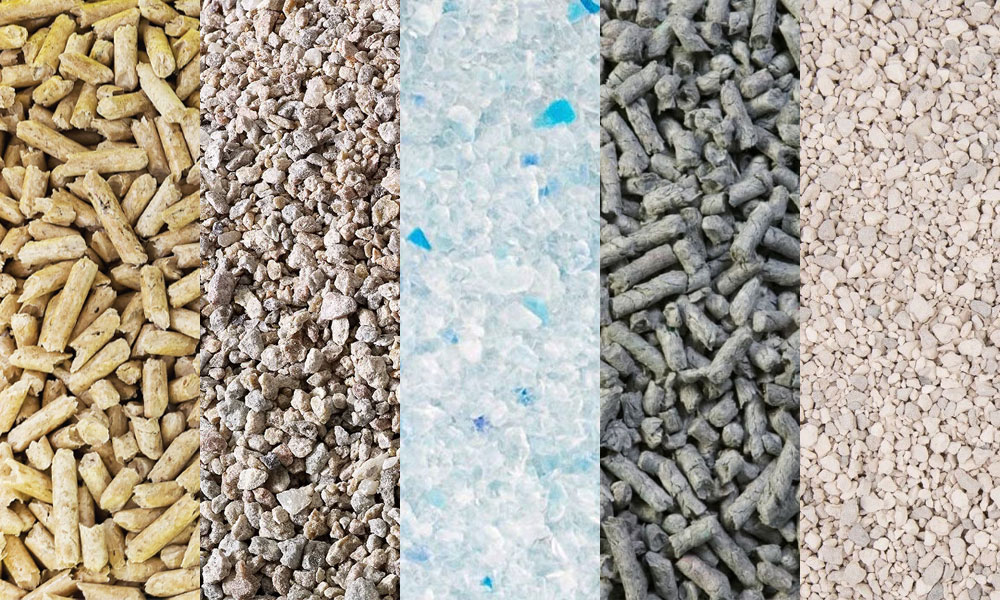Broadly speaking, there are three main types of cat litter available in the shops – wood and paper-based, silica, and clay in non-clumping and clumping varieties. I am only going to talk about the ones we have used or had experience with, and why we use the one that we do.
Clumping clay cat litter
We typically wouldn’t recommend clumping cat litter. Many clumping litters contain quartz silica and sodium bentonite, which are unsafe for kittens to ingest. A small amount of these chemicals will only cause stomach problems for a kitten.
Clumping cat litter expands as it absorbs moisture (my research says it can expand up to 15 times larger when wet) and consuming this type of litter can cause your kitten to become seriously ill. Even small amounts can cause blockages. Obviously, this is only a problem if a kitten eats it, but as breeders with curious learning kittens, it’s definitely a no from us.
From working alongside vets and in catteries, I have also found clumping clay litter can stick to cats paws and get trodden through the house, which is annoying to clean up! I have never used this litter with my rags, but I can imagine that clumping clay on the toe fluff is uncomfortable.
The one benefit of clumping cat litter is that it is good at absorbing moisture, making it easy to remove soiled litter from the tray. Non-clumping litters tend not to absorb much moisture at all.
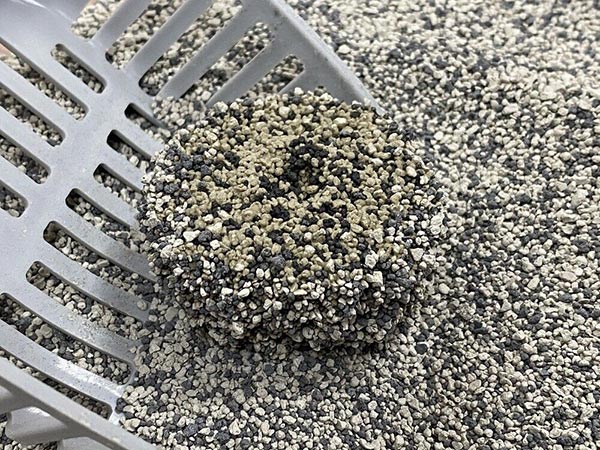
| Pros | Cons |
|---|---|
| One of the cheaper brands | Can be toxic if ingested (may contain silica dust) |
| Clumps when wet - easy to scoop clean | Not advised for kittens under 4 months |
| Can last longer than some litters as you don't always need a full tray clean once used | Gets stuck on paw fluff and can be trodden through the house |
| Not biodegradeable | |
| Production process harmful to the environment | |
| Gets trodden through the house |
Non-clumping clay cat litter
This litter won’t expand like clumping clay litter, so it won’t expand in a curious kitten’s belly if swallowed. However, I still avoid it with our growing kittens. Non-clumping cat litter pieces are small, so can still be ingested and cause an adverse reaction due to the chemicals found in some brands. Most off-the-shelf non-clumping cat litters contain silica dust, which can be harmful to young kittens. I also personally find it to be very dusty. For these reasons, I tend to completely avoid clay litter.
As clay cat litter is not biodegradable, much of the waste ends up in landfill where it will likely stay forever. I won’t name popular brands here, but the packaging will be labelled” non clumping clay litter”.
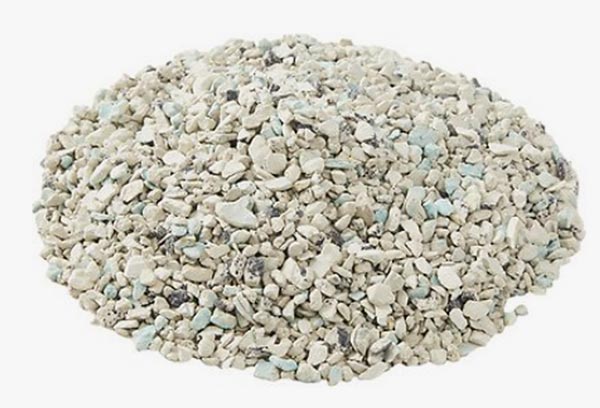
| Pros | Cons |
|---|---|
| One of the cheapest types of litter | Con be toxic if ingested (may contain silica dust) |
| Very absorbent | Not advised for kittens under 4 months |
| Can get stuck in paws and cause discomfort | |
| Not biodegradeable | |
| Production process is harmful to the environment | |
| Gets smelly quickly with full tray changes required | |
| Gets trodden through the house |
Silica Gel Litter
Unlike clay litter, crystal cat litter is non-toxic and totally safe for cats and humans. Even though crystal litter is made from silica gel, it does not contain the crystalline silica (the silica dust mentioned earlier) that makes clay litter dust potentially dangerous to inhale or ingest. Crystal cat litter is made from non-toxic amorphous silica.
When using silica gel litter, it is important to make sure the ingredients say amorphous silica gel as this is not harmful or toxic to cats and especially new-born kittens. This is not to say that kittens should be eating it, as it can still cause an obstruction. Due to the smaller pieces, we also avoid this when we have kittens in the house. However, I am not against using this type of cat litter, and have no issue with older cats using it once they are fully litter-trained and less likely to eat it.
Silica gel litter can still be tracked through the house after the cat has used the tray, but as it’s non-clumping I don’t find it sticks to their toe fluff as much as other litters. It is lightweight, traps the litter tray smell, and is easy to clean.
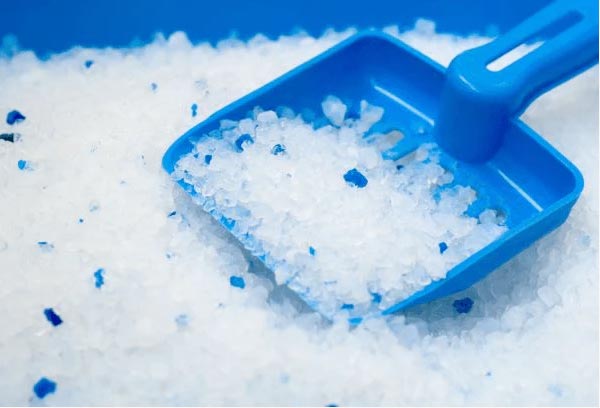
| Pros | Cons |
|---|---|
| Non-toxic | Production process harmful to the environment |
| Very absorbent | Quite expensive |
| Low dust | Treads through the house |
| Lightweight | Not biodegradeable |
| Less-frequent tray changes required | Can be uncomfortable on soft paws |
| Can produce dust, which is a known carcinogen |
Paper litter
Made from 95% post-consumer recycled paper, this litter is biodegradable and eco-friendly. The soft texture is great for senior cats or those with sensitive paws and makes a great transition litter as it is similar to clay. It doesn’t clump, but instead expands slightly when wet. Personally I still find kittens try to eat the litter, so I avoid it when I have kittens. Although the litter doesn’t have that ‘litter smell’ or dust, I find it isn’t good at absorbing the smell once the girls have used it. We find we change it more than the silica gel crystals.
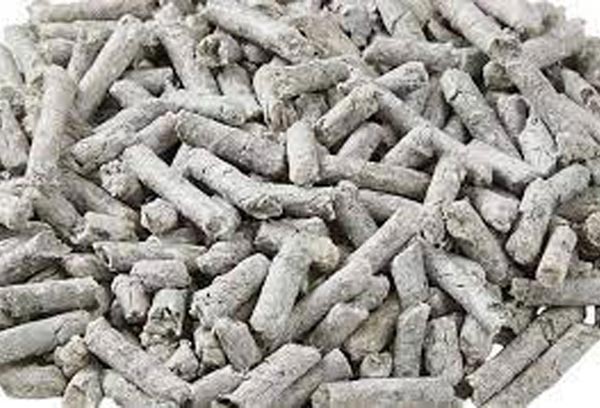
| Pros | Cons |
|---|---|
| One of the cheapest types | Does not clump and lower absorbency |
| Eco-friendly, recyclable material | More frequent tray changes required |
| Good for long-haired cats - doesn't get stuck in fur and paws |
The best cat litter for ragdolls (in our opinion): Wood pellet litter
I would recommend wood pellet cat litter for ragdolls above the other available options.
I don’t have a preferred brand; any large bag of wood pellet litter that my independent pet shop sells is fine. I like to try and support small businesses! I love that the individual pieces of litter are quite large and I’ve never had a kitten try to swallow it whilst learning to use the tray. It does get kicked out of the box when the cats dig in the litter or leave the tray, but it is quite easy to clean up and doesn’t stick in their toe fluff, so they can’t track it around the house. There is no dust produced by this cat litter either, which is great!
Wood litter doesn’t clump, so it’s not as easy to clean out urine from the tray. It is often better to do a full tray change rather than try to remove patches of used litter. I aim to change the tray at least once a day, but it is often more depending on the number of cats and kittens using it. So long as you remove poops soon after they happen, the litter rarely smells until it is heavily used.
Being made from wood, this cat litter is renewable, biodegradable, and 100% sustainable. If you home a kitten from us, we will supply you with a bag of our litter if you need it and recommendations of where to buy a similar type. You can max this litter with your chosen type to slowly transition to the new litter type or brand if you wish.
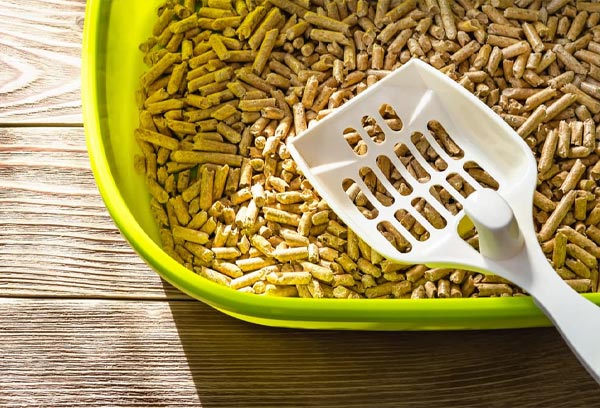
| Pros | Cons |
|---|---|
| Helps avoid litter tray smell without artificial additives | Large pellets can take some getting used to on soft paws |
| Large pellets are easy to clean up | Non-clumping, so more frequent tray changes required |
| Good for long-haired cats - no sticking in fur and paws | |
| Made from sustainable, renewable materials | |
| One of the cheapest to buy | |
| Good for younger kittens - pellets generally too big to eat and less harmful than other litters |
